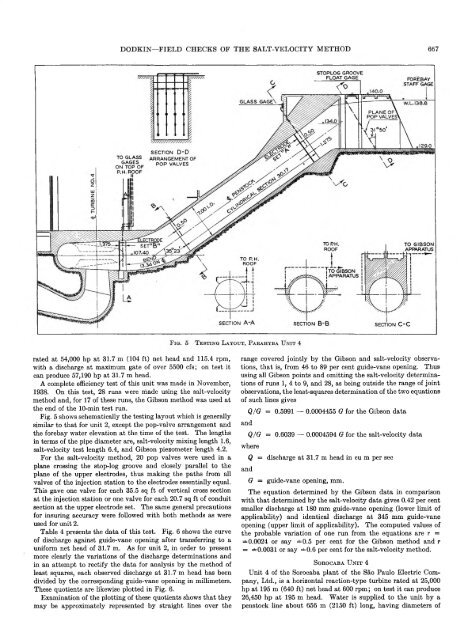Transactions A.S.M.E.
Transactions A.S.M.E.
Transactions A.S.M.E.
You also want an ePaper? Increase the reach of your titles
YUMPU automatically turns print PDFs into web optimized ePapers that Google loves.
DODKIN—FIELD CHECKS OF TH E SALT-VELOCITY METHOD 667<br />
rated at 54,000 hp at 31.7 m (104 ft) net head and 115.4 rpm,<br />
with a discharge at maximum gate of over 5500 cfs; on test it<br />
can produce 57,190 hp at 31.7 m head.<br />
A complete efficiency test of this unit was made in November,<br />
1938. On this test, 28 runs were made using the salt-velocity<br />
method and, for 17 of these runs, the Gibson method was used at<br />
the end of the 10-min test run.<br />
Fig. 5 shows schematically the testing layout which is generally<br />
similar to that for unit 2, except the pop-valve arrangement and<br />
the forebay water elevation at the time of the test. The lengths<br />
in terms of the pipe diameter are, salt-velocity mixing length 1.6,<br />
salt-velocity test length 6.4, and Gibson piezometer length 4.2.<br />
For the salt-velocity method, 20 pop valves were used in a<br />
plane crossing the stop-log groove and closely parallel to the<br />
plane of the upper electrodes, thus making the paths from all<br />
valves of the injection station to the electrodes essentially equal.<br />
This gave one valve for each 35.5 sq ft of vertical cross section<br />
at the injection station or one valve for each 20.7 sq ft of conduit<br />
section at the upper electrode set. The same general precautions<br />
for insuring accuracy were followed with both methods as were<br />
used for unit 2.<br />
Table 4 presents the data of this test. Fig. 6 shows the curve<br />
of discharge against guide-vane opening after transferring to a<br />
uniform net head of 31.7 m. As for unit 2, in order to present<br />
more clearly the variations of the discharge determinations and<br />
in an attem pt to rectify the data for analysis by the method of<br />
least squares, each observed discharge at 31.7 m head has been<br />
divided by the corresponding guide-vane opening in millimeters.<br />
These quotients are likewise plotted in Fig. 6.<br />
Examination of the plotting of these quotients shows that they<br />
may be approximately represented by straight lines over the<br />
range covered jointly by the Gibson and salt-velocity observations,<br />
that is, from 46 to 89 per cent guide-vane opening. Thus<br />
using all Gibson points and omitting the salt-velocity determinations<br />
of runs 1, 4 to 9, and 28, as being outside the range of joint<br />
observations, the least-squares determination of the two equations<br />
of such lines gives<br />
and<br />
Q/G = 0.5991 — 0.0004455 G for the Gibson data<br />
Q/G = 0.6039 — 0.0004594 G for the salt-velocity data<br />
where<br />
and<br />
Q = discharge at 31.7 m head in cu m per sec<br />
G = guide-vane opening, mm.<br />
The equation determined by the Gibson data in comparison<br />
with that determined by the salt-velocity data gives 0.42 per cent<br />
smaller discharge at 180 mm guide-vane opening (lower limit of<br />
applicability) and identical discharge at 345 mm guide-vane<br />
opening (upper limit of applicability). The computed values of<br />
the probable variation of one run from the equations are r =<br />
=*=0.0024 or say =*=0.5 per cent for the Gibson method and r<br />
= ±0.0031 or say =*=0.6 per cent for the salt-velocity method.<br />
S o r o c a b a U n i t 4<br />
Unit 4 of the Sorocaba plant of the Sao Paulo Electric Company,<br />
Ltd., is a horizontal reaction-type turbine rated at 25,000<br />
hp at 195 m (640 ft) net head at 600 rpm; on test it can produce<br />
26,450 hp at 195 m head. Water is supplied to the unit by a<br />
penstock line about 656 m (2150 ft) long, having diameters of

















